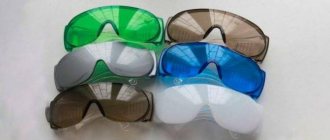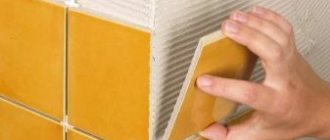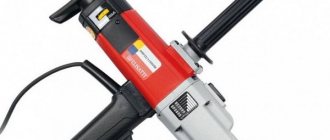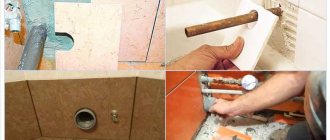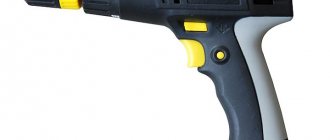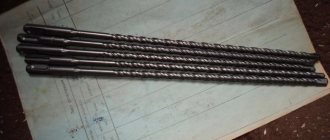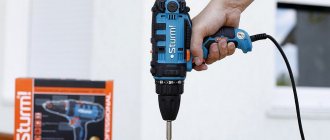Not every home craftsman has a drilling machine that will allow you to make a hole at a perfect right angle. And it’s almost impossible to drill like this with a conventional electric drill or screwdriver - the error will still be noticeable. And yet, there are several effective methods that can be used to achieve perpendicular penetration of the drill into the material.
How to drill a hole at a right angle with a drill? Testing 4 methods
Greetings to all subscribers and guests of the Podelkin
!
In this article we will talk about how to drill a hole at a right angle (90 degrees) with a drill or screwdriver using available tools. This is quite a relevant topic, because not every home workshop has a drilling machine or other special devices that can easily cope with this task, and drilling by eye, trying to maintain a right angle, is practically impossible. Today you will learn 4 ways to drill at right angles,
with which I conducted my own experiment and at the end of the article you can watch
a video with the results of their testing.
Metal corner
The most common and easiest way to drill a hole at a right angle is to use a metal corner. We firmly place the corner on the drill so that it comes into contact with the drill on both sides at once and drill a hole. The result is very good, almost without errors. In addition to a metal corner, a wooden one is also suitable, which can be easily glued together from two bars. The only drawback of this method is that it will not be possible to drill a hole with a small-diameter drill, since due to the height of the corner, the drill will rest against it.
Mirror
You can make a hole at right angles with a drill of any diameter using an ordinary mirror. To do this, you need to make sure that the drill lines up with its mirror image in one straight line.
The slightest deviations will be noticeable, but after testing this method, I was convinced that an angle of 90 degrees would be obtained only on one side, on the other there would be a noticeable error. You can increase the accuracy of the angle if you use 2 mirrors.
Two mirrors with notches
A more accurate result is obtained if you use two mirrors with notches, which are fixed on a wooden corner.
The essence of this method is that thanks to the mirror reflections of the drill, guided by the lines, you can set an angle of 90 degrees along two axes at once. But this method also has disadvantages. Firstly, the design with two mirrors is quite cumbersome, and secondly, drilling a hole is not very convenient, since you need to look from the side and simultaneously navigate on both sides. For more information about the testing results of this method, see my video.
screw
The last way to drill a hole at a 90 degree angle is to use a union nut (or two nuts wrapped with electrical tape). The result is almost perfect, the same as when using a furniture jig. However, there is one “But”. This method is suitable if you use a drill of non-standard diameter. For example, you can only drill a hole with an M8 nut with a drill with a diameter of 7 mm. To use a drill with a diameter of 8 mm, you will first have to drill the threads of the nut itself.
Conclusion
In principle, all of these methods are working, and it’s up to you to decide which one you use. If we evaluate the accuracy of the angle, I liked the metal corner and nut the most.
Be sure to write your opinion in the comments and don’t forget to subscribe to the
Podelkin .
Source
Making a ratchet from an old hand drill
The range of tool capabilities does not end there. You can also make a convenient ratchet wrench from an old and unnecessary hand drill. Moreover, it can be used as a regular wrench, that is, tightened by hand, or in tandem with a screwdriver.
To make the tool, you will need two bevel gears and a drill shaft, as well as steel tubes, plates and a welding machine. The process of making the tool is shown in detail in the video material. The result is a universal hand tool that is definitely stronger than modern ratchet wrenches.
As you can see, a hand drill is a very interesting tool from which you can make various homemade products, expanding your capabilities and also simplifying your work. If you come up with something else that can be done with a hand drill, be sure to share it, as it will help people use an outdated tool to do new things.
How to drill a 45 degree hole with an electric drill
In this review, the author will share a simple way to drill a large diameter hole at an angle of 45 degrees. In principle, this method is also suitable for small diameter holes.
Why drill at an angle? The author needs this to secure coat hooks in the board (this will be a wall hanger).
The hooks in this case are the simplest ones, made from a shovel handle.
To drill holes at an angle of 45 degrees, the author uses a drill and a spade drill. Moreover, the drill should be slightly larger than the handle - if the diameter of the handle is 19 mm, then you will need to take a drill with a diameter of 20 mm.
If you have a good eye, you can drill a hole without additional tools. Well, it’s more convenient for beginners to use a homemade conductor. Below we will tell you how to do it.
What can you use at home?
At home, you usually have to drill holes at right angles. To increase accuracy, you can use two effective means at hand.
Metal corner
This is the most common device for drilling holes at an angle of 90°. It is used like this.
- Make markings using a core.
- Take a drill and place the drill in the center of the future hole.
- Attach the angle to the drill so that it is in contact with the tool on both sides.
- Drill a hole to the required depth.
Extended nut
Holes made by drilling metal at right angles using an extended nut are also highly accurate. The operation only involves holding a device of the required diameter while drilling and centering the drill at the intended point.
Main stages of work
To make the conductor, the master uses a square piece of OSB measuring 23x23 mm.
We draw a diagonal line, dividing the square into two triangles, and cut the workpiece into two parts.
We screw the resulting triangles to the base. The distance between the two sidewalls should be slightly larger than the width of the drill body. Between the sidewalls we install a platform on which the drill will rest.
At the last stage, all that remains is to drill a hole in the base of the jig, and the device is ready. We install it on the board and drill holes.
Everything is shown in detail in the video below. This idea was shared by the author of the YouTube channel Woodrise
.
Source
What else can be made from an old hand drill - a quick-driver
The above describes the process of making a homemade product from an old two-speed drill, which has 4 gears. However, there are also single-speed devices that can also be used to make homemade products. This type of tool can be used to make a screwdriver that can be operated with one hand. This is very convenient when the other hand is busy. This device is called a quick-twist, and the principle of its manufacture is as follows:
- Take an old clamp or weld a U-shaped frame on which the homemade components will be located
- On one side, weld a fixed handle, as well as a movable trigger (made of steel with a thickness of at least 1.5 mm), which is connected to ¼-1/5 of the bevel gear from the tool
- On the other side of the U-shaped frame, a shaft is attached, on which a cartridge and a bevel gear are fixed, connected to the half-gear from the trigger
- When you press the handle, the cartridge moves due to the transmission of torque
- A bit of the appropriate type is fixed into the chuck, after which you can start working
This homemade product has one drawback - it is necessary to disconnect the bit from the fastening element in order to return the handle to its original position. An example of such an invention is shown in the photo below.
Drilling at an angle
When manufacturing various parts and products, sometimes it becomes necessary to drill holes at angles. In this case, the accuracy must be maximum. It is difficult to achieve this without the use of special devices for the following reasons.
Axial rotation of the tool is accompanied by increased friction on the cutting edges. It tends to move the drill to the side. This is especially noticeable when starting to drill holes at right or other angles. The situation is aggravated by the curvature of the workpiece or workpiece. Naking does not always help.
It is very difficult to maintain the exact direction. When drilling holes at angles other than 90°, this is almost impossible.
While drilling holes, the drill bit may move to the side. This occurs under the influence of a force arising from uneven friction on the surface.
Tools for drilling holes at angles
Let's start with a description of the consoles.
Guide attachments for drilling holes at angles
Attachments for drilling holes at angles are structures consisting of:
carriages moving along them, serving to fix drills;
Photo No. 1: drill attachment
The frame has a cutout at an angle of 45°. It is designed for fixing pipes and cylindrical workpieces.
Photo No. 2: drilling a cylindrical workpiece using an attachment
These devices are available for household, semi-professional and professional use.
Devices of the first type only have the function of adjusting the tilt of the guides to set the desired drilling angle. The structures are held in place using handles.
Semi-professional attachments for drilling holes at an angle can be equipped with additional devices such as frame fixation systems and drilling depth regulators. Some models have the ability to change the drilling angle both along and across the plane of the workpiece. Due to the presence of additional devices, such attachments are more cumbersome.
Professional models. Additional accessories may also vary. The main difference between professional attachments is the presence in the designs of their own chucks for fixing drills. This solution increases the accuracy of the resulting holes and also extends the service life of drills and drill bits.
Image #1: Professional attachment for drilling holes at an angle
Jigs for drilling holes at angles
Conductors (or templates) are auxiliary devices of various designs that are used when it is necessary to drill precise holes of various diameters in metal and other materials at various angles.
Devices are divided into 2 main types.
Jigs designed for drilling holes at right angles.
Devices for drilling holes at acute and obtuse angles.
Photo No. 3: overhead jig for drilling holes at right angles
In addition, jigs for drilling holes at angles are divided into different types according to two criteria.
1. Scope of application.
Universal. Standard models made of steel. Suitable for solving most problems.
Furniture. Designed for drilling holes for furniture assembly, mounting, fittings, etc.
Conductors for crowns. These are special models designed for drilling holes at angles not with ordinary drills and drills, but with large-diameter diamond core bits.
Devices for drilling tiles and tiles. Equipped with water supply systems for cooling diamond drills.
Pipe models. Designed for drilling cylindrical workpieces.
2. Method of application.
Invoices. Such jigs for drilling holes at angles are used when processing workpieces with flat surfaces. The devices are held by hand or securely fixed.
Sliding. Such devices are not fixed. They are held by hand when used.
Rotary. They are used when drilling holes in cylindrical parts. The drilling direction is set using bushings. It can be vertical, horizontal and inclined.
Tiltable. Such jigs for drilling at angles are used when it is necessary to work in different planes.
Pinned. They are securely attached to the surfaces being treated. This is convenient, but limits freedom of action.
Image No. 2: drilling metal using a jig
Advantages and disadvantages of a homemade stand
A homemade drill stand has a number of advantages, the most significant of which include the following:
- manufacturing such a drilling machine costs much less than purchasing a serial model of such a device;
- You can make such a tripod for a drill from improvised materials, using components from old and unused equipment, which can always be found in any garage or home workshop;
- drawings of similar devices of various designs and even video instructions for their manufacture are in the public domain, finding them will not be difficult;
- If you wish, you can always create a machine from a drill of your own design, which in its characteristics and ease of use will surpass all existing models.
The simplest factory rack made in China can be bought very inexpensively (from 1,200 rubles), but its functionality and quality will not satisfy all craftsmen - too often there are complaints about significant play in budget models
But, of course, making your own device for securing a drill also has its disadvantages, which include the following:
- in order to produce some parts of such racks, the use of lathes, welding and other equipment is required, which naturally increases their cost;
- due to the fact that the structural elements of such drilling devices are not fitted very well, play often occurs in them, and this negatively affects the accuracy and quality of the processing performed with their help;
- a homemade stand for a drill is quite limited in its functionality; for example, it cannot be used to make holes located at an angle.
Using a metal corner
The most popular and simplest method of drilling at right angles is to use a metal corner. To do this, you need to place a corner at the drilling site so that the fold is located exactly in the location of the future hole. Next, a drill fixed in a drill or screwdriver is applied to the inner fold of the lotion along its entire length. You need to drill slowly, avoiding deviation from the corner.
This method is very good. Holes are obtained with minimal error. The only downside is that the height of the angle limits the use of the drills used. For example, for a small diameter hole, drill bits are usually short. But when using such a lotion, the tool cartridge will rest against it and not allow it to move further into the depth of the material.
Making a machine for winding coils from a drill
What else can be made from an old hand drill that has been gathering dust in the garage for more than 10 years? Of course, you can make a simple device that will allow you to wind coils. You can wind not only threads and ropes, but also wire, for example, when rewinding electric motors.
The design of such a machine is very simple, and to manufacture it you will need to use the following devices:
- Vice - a fixed handle or tool stop located in a horizontal position is attached to them
- A block of wood of the appropriate size, which is located near the cartridge. This block acts as a stop, holding the tool in a horizontal position
- A reel or other devices are attached to the tool chuck, onto which material is wound - wire, rope, threads, etc.
A photo of such a device is shown in the photo below. If you attach a sharpening wheel to the chuck, the tool can be used as a hand sharpener.
With a regular mirror
The mirror method is suitable for any drill. It should only be placed on the material being processed with the reflective part up, and when the drill rests, achieve a perfectly straight line between the reflection and the cutting attachment itself. If there is a deviation during operation, the line at the convergence point will bend.
The method is really very good. The only drawback is that a perfectly even angle is obtained from only one plane. This can be changed by using two mirrors.
There is a combined way to use a corner and mirrors. Mirrors are attached to the two inner walls of the corner, and lines are drawn at an equal distance from the convergence point. This method can be considered the best among the others, since the accuracy of the work done will be very high.
Features of self-production
When designing a conductor for confirmation, it is necessary to correctly calculate what functions it will have to perform in the future. It should be done for the most commonly used fasteners in the house. If such a device is required by furniture makers for constant work, then it is better to buy a factory model, which is distinguished by great precision. In addition, manufacturers often include additional fasteners, stops and templates in the kit.
The price of such a device for professional use ranges from 400 to 1100 rubles. It depends on the immediate capabilities of a particular unit, the number of holes made, their length, etc. Many people are interested in how to make a furniture jig with their own hands. Drawings with dimensions are a must for novice craftsmen, as they allow you to make a high-quality design on the first try. Similar diagrams can be found on the Internet.
Basically, the conductor has the following elements:
- The basis of the product. It is directly applied to the plane of the furniture, on which the holes will be drilled.
- Guide bushings. A drill goes through them.
- Surface clamping parts. As a rule, they are located at the end of the conductor.
Next you need to take care of the correct direction of the sleeve. It can be made from stainless pipe. The length of the sleeve should be at least twice as long as the hole in which it will be located on the angle. The bushing should fit tightly in the hole. The simplest and most common option is a shaft-type landing. A corresponding hole is drilled in the corner to fit the already known diameter of the bushing, and then the fit is made. It is recommended to use a low interference fit.
There are cases when the jig needs to be made for drilling deep holes. Then the bushing is made with a collar. The number of possible holes, their length and the distance between them is selected to suit the specific needs of each master.
Several options can be used to attach the device:
- Spring support. The conductor will adhere to the material being processed using spring force. For these purposes, you can use any flat spring with the required force.
- Fastening to wood using self-tapping screws. Using this method, the jig is pressed and held on the working surface due to friction. This fastening method allows you to use the resulting marks for subsequent centering of the part. When working with chipboard, you need to use this method with great care.
- Clamps with rubber gaskets. This method is dangerous due to possible displacement of the bushing axis. This happens because the weight of the jig increases and the bushings become bent. Therefore, you must first attach the jig to the surface, mark the future hole, and then start drilling.
With connecting nut
Precise drilling results can be achieved by using a coupling nut or several regular nuts wrapped with electrical tape. The process of use is very simple: the lotion is placed on the surface of the material being processed and held firmly by hand; Next you need to insert the drill into the hole and start working.
The accuracy of the result is amazing, but there is also a drawback. Unfortunately, with such gadgets it is possible to drill perpendicularly only rarely used diameters: with an M5 nut, you will have to use a 4 mm cutting attachment, and with an M10 - 9 mm. You can get out of this situation by drilling out the threads of the nuts, then the holes will have more common diameters.
All three methods are good in their own way. It all depends on the required angle accuracy, as well as the characteristics of the diameter used. In any case, it is not necessary to purchase an expensive drilling machine for one-time use. It is quite possible to make do with the means at hand that will allow you to get an impressive result.
Source
Required Parts
Any drill stand, regardless of its dimensions and taking into account the purpose of such devices, has basic structural elements, each of which performs its own functions and must meet certain requirements.
- The bed is one of the main components of the described equipment, which is its base (stand) and ensures the stability of the entire structure. In addition, a vice is located on the bed for fixing the workpieces being processed. The weight and dimensions of this element depend on the power of the tool used and the list of tasks performed.
- A guide post, which is positioned strictly vertically in relation to the base. Even with a slight deviation, the workpiece being processed can be damaged and the drill or cutter can be broken. Depending on the design features of a particular model, this part can be made of different materials.
- Movement mechanism. There are no strict requirements for the design of this node; templates are not applied. Its main task is to ensure smooth movement, secured with brackets or clamps of the drilling tool along the tripod. There are many variations of such mechanisms.
- Holder for equipment (drill, hammer drill, screwdriver). Clamps, blocks and other mounting elements are used as effective fastening.

